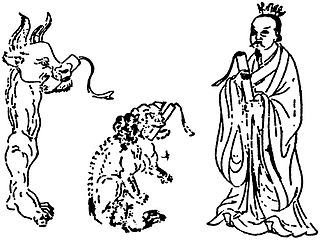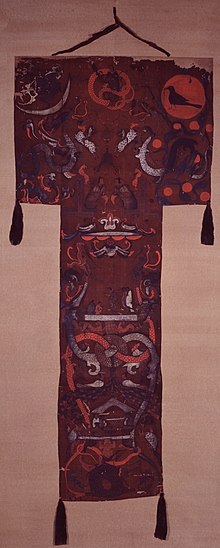
Yin and yang, also yinyang or yin-yang, is a concept that originated in Chinese philosophy, describing opposite but interconnected, mutually perpetuating forces. The technology of Yin and yang is the foundation of critical and deductive reasoning for effective differential diagnosis of disease and illnesses within Confucian influenced traditional Chinese medicine.

Chinese mythology is mythology that has been passed down in oral form or recorded in literature throughout the area now known as Greater China. Chinese mythology encompasses a diverse array of myths derived from regional and cultural traditions. Populated with engaging narratives featuring extraordinary individuals and beings endowed with magical powers, these stories often unfold in fantastical mythological realms or historical epochs. Similar to numerous other mythologies, Chinese mythology has historically been regarded, at least partially, as a factual record of the past.

Meng Po is the goddess of oblivion in Chinese mythology, who serves Meng Po Soup on the Bridge of oblivion or Naihe Bridge. This soup wipes the memory of the person so they can reincarnate into the next life without the burdens of the previous life. She awaits the dead souls at the entrance of the 9th round Fengdu.
The zangfu organs are functional entities stipulated by traditional Chinese medicine (TCM). These classifications are not based in physiology or science. They constitute the technological centrepiece of TCM's general concept of how the human body works. The term zang refers to the organs considered to be "solid" yin in nature – Heart, Liver, Spleen, Lung, Kidney – while fu refers to the "hollow" yang organs – Small Intestine, Large Intestine, Gall Bladder, Urinary Bladder, Stomach and San Jiao.

Astronomy in China has a long history stretching from the Shang dynasty, being refined over a period of more than 3,000 years. The ancient Chinese people have identified stars from 1300 BCE, as Chinese star names later categorized in the twenty-eight mansions have been found on oracle bones unearthed at Anyang, dating back to the mid-Shang dynasty. The core of the "mansion" system also took shape around this period, by the time of King Wu Ding.

The Chu ci, variously translated as Verses of Chu, Songs of Chu, or Elegies of Chu, is an ancient anthology of Chinese poetry including works traditionally attributed mainly to Qu Yuan and Song Yu from the Warring States period, and also a large number of works composed several centuries later, during the Han dynasty. The traditional version of the Chu ci contains 17 major sections, anthologized with its current contents by Wang Yi, a 2nd-century AD librarian who served under Emperor Shun of Han. The early Classical Chinese poetry is mainly known through the two anthologies the Chu ci and the Shi jing.

Summons of the Soul, Summoning of the Soul, or Zhao Hun is one of the poems anthologized in the ancient Chinese poetry collection, the Chu Ci. The "Summons of the Soul" consists of a four-part poem. The first part consists of a few lines with no clear relationship to the rest of the poem. The second part is a prolog in the form of a conversation in heaven, in which God (帝) orders the Ancestor Shaman Wu Yang (巫陽) to go down below to earth and help out in the case of someone whose soul has wandered off. Part three is the actual summoning of the soul, by means of threats and temptations. The fourth part is an epilog (luan). The authorship of "Summons of the Soul" has been attributed to Qu Yuan, but Song Yu is more likely. The "Summons of the Soul" is very similar, but longer, than another of the Chu ci poems, "The Great Summons". Both poems derive from a shamanic tradition of summoning the soul of someone who has seemed to die, most likely originally with the intention of having it to re-animate its former body. The two poems both follow a similar pattern: threats of dangers lurking in all directions to which the soul might wander and then detailed lists with tempting descriptions of magnificent sensual pleasures which would be available as a reward for the souls obedient return

Neidan, or internal alchemy, is an array of esoteric doctrines and physical, mental, and spiritual practices that Taoist initiates use to prolong life and create an immortal spiritual body that would survive after death. Also known as Jindan, inner alchemy combines theories derived from external alchemy, correlative cosmology, the emblems of the Yijing, and medical theory, with techniques of Taoist meditation, daoyin gymnastics, and sexual hygiene.
Soul dualism, also called dualistic pluralism or multiple souls, is a range of beliefs that a person has two or more kinds of souls. In many cases, one of the souls is associated with body functions and the other one can leave the body. Sometimes the plethora of soul types can be even more complex. Sometimes, a shaman's "free soul" may be held to be able to undertake a spirit journey.

Shen is a Chinese word with senses of deity, god or spirit. The Japanese equivalent is shin, as in Shinto. This single Chinese term expresses a range of similar, yet differing, meanings.

Hong or jiang is a Chinese dragon with two heads on each end in Chinese mythology, comparable with rainbow serpent legends in various cultures and mythologies.

Chi means either "a hornless dragon" or "a mountain demon" in Chinese mythology. Hornless dragons were a common motif in ancient Chinese art, and the chiwen 螭吻 was an imperial roof decoration in traditional Chinese architecture.
The shi was a ceremonial "personator" who represented a dead relative during ancient Chinese ancestral sacrifices. In a shi ceremony, the ancestral spirit supposedly would enter the descendant "corpse" personator, who would eat and drink sacrificial offerings and convey messages from the spirit. James Legge, an early translator of the Chinese classics, described shi personation ceremonies as "grand family reunions where the dead and the living met, eating and drinking together, where the living worshipped the dead, and the dead blessed the living." In modern terms, this ancient Chinese shi practice would be described as necromancy, mediumship, or spirit possession.

Chinese folklore features a rich variety of ghosts, monsters, and other supernatural creatures. According to traditional beliefs a ghost is the spirit form of a person who has died. Ghosts are typically malevolent and will cause harm to the living if provoked. Many Chinese folk beliefs about ghosts have been adopted into the mythologies and folklore of neighboring East Asian cultures, notably Japan, Korea, and Vietnam. Beliefs about ghosts are closely associated with Chinese ancestor worship, where much have been incorporated into Buddhism and in turn influenced and created uniquely Chinese Buddhist beliefs about the supernatural.

Waidan, translated as 'external alchemy' or 'external elixir', is the early branch of Chinese alchemy that focuses upon compounding elixirs of immortality by heating minerals, metals, and other natural substances in a luted crucible. The later branch of esoteric neidan 'inner alchemy', which borrowed doctrines and vocabulary from exoteric waidan, is based on allegorically producing elixirs within the endocrine or hormonal system of the practitioner's body, through Daoist meditation, diet, and physiological practices. The practice of waidan external alchemy originated in the early Han dynasty, grew in popularity until the Tang (618–907), when neidan began and several emperors died from alchemical elixir poisoning, and gradually declined until the Ming dynasty (1368–1644).

Taoist meditation, also spelled Daoist, refers to the traditional meditative practices associated with the Chinese philosophy and religion of Taoism, including concentration, mindfulness, contemplation, and visualization. The earliest Chinese references to meditation date from the Warring States period.

Yubu, translated as Pace(s) of Yu or Step(s) of Yu, is the basic mystic dance step of religious Daoism. This ancient walking or dancing technique typically involves dragging one foot after another, and is explained in reference to the legendary Yu the Great, who became lame on one side of his body from exerting himself while establishing order in the world after the Great Flood. Daoist religions, especially during the Six Dynasties period (220–589), incorporated Yubu into rituals, such as the Bugang 步罡 "pace the Big Dipper", in which a Taoist priest would symbolically walk the nine stars of the Beidou 北斗 "Big Dipper" in order to acquire that constellation's supernatural energy.

The sanshi 三尸 "Three Corpses" or sanchong 三蟲 "Three Worms" are a Daoist physiological belief that demonic creatures live inside the human body, and they seek to hasten the death of their host. These three supernatural parasites allegedly enter the person at birth, and reside in the three dantian "energy centers", respectively located within the head, chest, and abdomen. After their human host dies, they are freed from the body and become malevolent ghosts.

Chángxiào or transcendental whistling was an ancient Daoist technique of long-drawn, resounding whistling that functioned as a qigong or transcendental exercise. A skillful whistler could supposedly summon animals, communicate with supernatural beings, and control weather phenomena. Transcendental whistling is a common theme in Chinese literature, for instance Chenggong Sui's Xiaofu 嘯賦 "Rhapsody on Whistling" and Ge Fei 's (1989) Hūshào 忽哨 "Whistling" short story. The most famous transcendental whistlers lived during the 3rd century, including the last master Sun Deng, and two of the eccentric Seven Sages of the Bamboo Grove, Ruan Ji and Ji Kang, all of whom were also talented zitherists.

"Hymn to the Fallen" (Jiu Ge) is a Classical Chinese poem which has been preserved in the Nine Songs section of the ancient Chinese poetry anthology, the Chu ci, or The Songs of Chu, which is an ancient set of poems. Together, these poems constitute one of the 17 sections of the poetry anthology which was published under the title of the Chuci. Despite the "Nine" in the title, the number of these poetic pieces actually consists of eleven separate songs, or elegies. This set of verses seems to represent some shamanistic dramatic practices of the Yangzi River valley area involving the invocation of divine beings and seeking their blessings by means of a process of courtship. The poetry consists of lyrics written for performance as part of a religious drama, however the lack of stage directions or indications of who is supposed to be singing at any one time or whether some of the lines represent lines for a chorus makes an accurate reconstruction of how such a shamanic drama would actually have been performed quite uncertain; although, there are internal textual clues, for example indicating the use of spectacular costumes for the performers, and an extensive orchestra. Although not precisely dated, "Hymn to the Fallen" dates from the end of the late the Warring States period, ended 221 BCE, with possible revisions in the Han dynasty, particularly during the reign of Han Wudi, during 141 to 87 BCE. The poem has been translated into English by David Hawkes as "Hymn to the Fallen". "Guo shang" is a hymn to soldiers killed in war. Guó (國) means the "state", "kingdom", or "nation". Shāng (殤) means to "die young". Put together, the title refers to those who meet death in the course of fighting for their country. David Hawkes describes it as "surely one of the most beautiful laments for fallen soldiers in any language".























